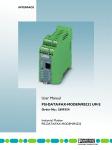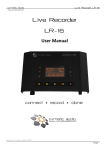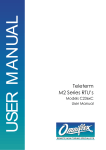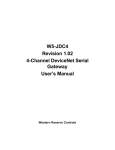Download Omni30 Series Alarm Annunciators
Transcript
Omni30 Series Alarm Annunciators DATE Aug 2002 Jan 2003 Mar2003 June 2011 REVISION 1 2 3 4 COMMENTS Initial revision Corrections for Production Edited for distribution Corrected Text on Sequence Diagrams SOFTWARE COPY AVAILABLE This manual is available in printed form or in Adobe Acrobat pdf format. The Acrobat Portable Document File is named UMC1620AR03.pdf COPYRIGHT AND PROTECTIVE NOTICES 1. The Copyright of this document and the associated drawings, is the property of Omniflex and is issued on condition that it is not copied, reprinted or reproduced or transmitted in any form or by any means, electronically, photocopying, mechanical or otherwise, nor its contents disclosed, either wholly or in part, without the consent in writing of, or in accordance with the conditions of a contract with Omniflex. 2. The publication of information in the document does not imply freedom from patent or other protective rights of Omniflex or others. 3. Although every intention is made to ensure that performance figures and data are accurate the company reserves the right to alter without notice any product or specification. Performance figures and data must therefore be specifically confirmed by the company before they become applicable to any tender, order or contract. 4. 5. In the case of electrical components, enough data is included in the drawings to allow maintenance of the equipment. However, if component availability or substitution information is required please consult the factory for assistance, as it is impossible to include data on every component in this document. This product is sold without liability for consequential loss of any description. Omni30 User Manual UMC1620AR04 -2- © Omniflex SCOPE This User Manual provides information necessary to install, configure and operate your Omni30 product. This manual covers the following product Model Numbers: Model Product Description C1620 Omni30/8 8 Way Alarm Module Panel Mount (483mmW x 44.5mmH) C1620-1 Omni30/8-SL 8 Way Alarm Module 19 inch Rack mount (483mmW x 44.5mmH) C1621 Omni32/8 4 Way Alarm + Control Module Panel Mount (483mmW x 44.5mmH) C1621-1 Omni32/8-SL 4 Way Alarm + Control Module 19 inch Rack Mount (483mmW x 44.5mmH) C1622 Omni33/8 8 Way Control Module Panel Mount (483mmW x 44.5mmH) C1622-1 Omni33/8-SL C1623 Omni30/4 C1624 Omni33/4 8 Way Control Module 19 inch Rack Mount (483mmW x 44.5mmH) 4 Way Alarm Module Panel Mount (267mmW x 44.5mmH) Control Module Panel Mount (267mmW x 44.5mmH) Introduction The OMNIFLEX Omni30 family is a range of alarm annunciators designed using the OMNIFLEX Omni16c alarm annunciator technology, packaged in 10.5inch and 19inch housings, in 4 and 8 way configurations. All products in the range are available “off-the-shelf” with no factory customisation required. Because these units are not built to order, spares holding and maintenance are significantly reduced. Alarm display options include long-life incandescent lamps for lowest initial cost, or highbright back-lit LED’s for best life cycle cost and lowest power consumption and reliability. Display legends for the backlit displays are created by the user on any standard laser/inkjet printer using software templates supplied with the product. All popular configuration options are accomplished by switch settings externally available on the unit. Additional options include: • 27 alarm sequences as standard for widest range of applications. • Flash synchronisation between modules. • A Software Configuration Utility for more advanced customisation. Omni30 User Manual UMC1620AR04 -3- © Omniflex • Fully isolated RS232/422/485 Modbus © compatible serial port to interface to PLC, DCS, or SCADA systems. The Omni30/4 Panel Mount 4 point Alarm Annunciator. The Omni30/8 Panel Mount 8 point Alarm Annunciator. The Omni32/8 Panel Mount 4 point alarm & Control Module The Omni33/4 Panel Mount Control Module The Omni33/8 Panel Mount Control Module Omni30 User Manual UMC1620AR04 -4- © Omniflex Table of Contents 1. GENERAL DESCRIPTION ............................................................................................... 7 1.1 Standard Features ........................................................................................................ 7 1.2 Options available........................................................................................................... 7 1.3 Rear Views of the Omni30 Series products ................................................................ 7 2. MECHANICAL INSTALLATION ....................................................................................... 9 2.1 Mechanical Dimensions ................................................................................................ 9 2.2 Panel Mounting ............................................................................................................. 9 2.3 19 inch Rack Mounting ................................................................................................. 9 2.4 Installing Back-lit LED boards .................................................................................... 10 2.5 Installing Incandescent Lamps................................................................................... 10 2.6 Creating Window Legends for Back-lit Display Windows........................................ 10 2.6.1 Overview ................................................................................................................................................................ 10 2.6.2 Creating the Legend Film................................................................................................................................................. 10 2.7 Inserting Legends and Colour Filters into Back-lit Display Windows ..................... 11 2.7.1 Colour of Windows ......................................................................................................................................................... 11 2.7.2 Assembling Back-lit Display Windows ................................................................................................................................ 11 2.7.3 Removing Backlit Display Windows ................................................................................................................................... 12 3. ELECTRICAL INSTALLATION....................................................................................... 13 3.1 Introduction .................................................................................................................. 13 3.2 Omni30 Alarm Input Connections .............................................................................. 13 3.3 Omni30 Common Service Connections using an Omni30 Control Module........... 14 3.4 Omni30 Common Service Connections using external Horn and Pushbuttons .... 15 3.5 Creating two First Out Groups using a single Control Module................................ 15 3.6 Omni30 Serial Port Pinout .......................................................................................... 16 3.7 Power Requirements .................................................................................................. 17 4. CONFIGURING THE OMNI30 FOR OPERATION....................................................... 18 4.1 Introduction .................................................................................................................. 18 4.2 Modes of Operation .................................................................................................... 18 4.3 Selecting the alarm/display logic sequences ............................................................ 19 4.4 Selecting the Group Alarm Output Function ............................................................. 21 4.5 Selecting the Lamp Status ......................................................................................... 21 4.6 Selecting Time Delays ................................................................................................ 21 4.6.1 Omni30 Fast and Slow Timers .......................................................................................................................................... 22 4.6.2 Explanation of Timer Operation in a Timer Sequence ........................................................................................................... 22 4.7 Selecting Serial Port Settings .................................................................................... 22 5. OPERATION .................................................................................................................... 25 5.1 Power-up...................................................................................................................... 25 5.2 Normal Operation ........................................................................................................ 25 5.3 Test Functions ............................................................................................................. 25 Omni30 User Manual UMC1620AR04 -5- © Omniflex 5.3.1 Overview of the Test Functions......................................................................................................................................... 25 5.3.2 Pressing the Test Button ................................................................................................................................................. 25 5.3.3 Fault Indication on Circuit Test.......................................................................................................................................... 26 5.3.4 Manually invoking the Circuit Test Function. ....................................................................................................................... 26 5.3.5 The “Marching Sequence” Circuit Test Display .................................................................................................................... 26 6. SPECIFICATIONS ........................................................................................................... 28 7. ALARM SEQUENCE DIAGRAMS.................................................................................. 31 8. MODBUS REGISTER LAYOUT ..................................................................................... 44 Omni30 User Manual UMC1620AR04 -6- © Omniflex 1. GENERAL DESCRIPTION 1.1 Standard Features • • • • • • • • 1.2 Options available • • 1.3 Standard 4 and 8 point modules allow integral systems from 4 to 128 points to be constructed by the user. All products in the range are supplied off-the-shelf with no factory customisation required, to minimise spares holding. Panel mounted display options include long-life incandescent lamps or high-bright back-lit LED’s. User-created display legends on standard laser/inkjet printer using software templates supplied – no window engraving required. Plug-in terminals for easy installation and maintenance. Switch selectable Normally Open or Normally Closed input contact sense selection while installed. No dismantling required. 27 switch selectable alarm sequences built in, covering most alarm annunciator specifications and configurations. 24Volt dc powered. Fully isolated RS232/422/485 Modbus © compatible serial port to interface to PLC, DCS, or SCADA systems. Advanced Software Configuration Utility to configure the Omni30 in “SOFT-SET” mode for more specialised applications. Rear Views of the Omni30 Series products Figure 1-1 – Panel Mount Omni30/4 Rear View Figure 1-2 – Panel Mount Omni33/4 Rear View Omni30 User Manual UMC1620AR04 -7- © Omniflex Omni30 Figure 1-3 – Omni30/8 Rear View Omni32 Figure 1-4 – Omni32/8 Rear View Omni33 Figure 1-5 – Omni33/8 Rear View Omni30 User Manual UMC1620AR04 -8- © Omniflex 2. MECHANICAL INSTALLATION 2.1 Mechanical Dimensions Figure 2-1 –Omni30 Mechanical Dimensions 2.2 Panel Mounting The panel mounted Omni30 series units may be mounted individually or in groups in a single cut-out in the panel. Each annunciator is mounted using its own mounting studs. See the Mechanical Dimensions above for detailed requirements for the cutout. If incandescent lamps are installed in the windows in these units, then the maximum number of units recommended in a single cut-out is 6 units to prevent excessive heat buildup. 2.3 19 inch Rack Mounting Some of the Omni30 Series units are available in 19inch Rack mountable enclosures. Omni30 User Manual UMC1620AR04 -9- All 19 inch Rack mounted units are 1U (44.45mm) in height. If incandescent lamps are installed in the windows in these units, then the maximum number of units recommended to stack without a ventilation gap is 6 units to prevent excessive heat build-up. 2.4 Installing Back-lit LED boards Back-lit LED boards are installed through the front windows of the unit. To install an LED board in a window, follow this procedure: 1. Snap out the relevant clear plastic window using slot in the centre (see 2.7.3). 2. Remove any lamps that may already be installed. (Backlit LED boards can be installed in units that have incandescent lamp holders installed, but only after the bulbs have been removed.) 3. Using a pair of long-nose pliers, grip the backlit LED board by the central connector, and carefully insert on to the gold pins located in the centre of the window. 4. Press the board firmly into position so that the white locating spacer clips into the locating hole in the back of the window. Markings on the LED board indicate the correct insertion orientation. If an LED board is inserted the wrong way around, it will not work, but no damage will be done. 2.5 Installing Incandescent Lamps If the Omni30 Alarm unit has incandescent lamp-holders fitted, then the incandescent lamps may be fitted and changed through the front windows. To install the lampholders themselves, however, the Lamp display Assembly must be removed from the main housing. Consult your nearest OMNIFLEX distributor for assistance in installing incandescent lamp holders. 2.6 Creating Window Legends for Back-lit Display Windows 2.6.1 Overview Legends are created for the Omni30 on a laser or inkjet printer using the software templates provided with the product. Templates for popular programs are supplied on a 3,5” ‘stiffy’ diskette with your unit. There are templates for Microsoft Word and Microsoft PowerPoint to run on an IBM compatible computer running the Windows95, Windows 98 or Windows NT/2000/XP operating systems. There is also a README.TXT file on this disk. Read this first to see which versions of program are compatible with these templates. 2.6.2 Creating the Legend Film To create the legend film, follow this procedure: 1. Start the application program you wish to use. 2. Open the appropriate template from the ‘stiffy diskette’ supplied. 3. Fill in your legend details in this template. 4. Print the legends created onto overhead transparency film (the type used for overhead presentations). A sheet is included with the product. Omni30 User Manual UMC1620AR04 - 10 - 5. Cut along the cut marks which will print onto the film to produce the number of individual legends required. 6. Insert them into the Omni30 as described in section 2.7. Please note that the supplied templates have been tested on a wide range of printers. Your particular printer may scale the image slightly differently. While the front grid markings should accommodate this tolerance, in exceptional circumstances you may have to alter the grid spacing on the template supplied. This needs to be done once only and will then be set for your printer. 2.7 Inserting Legends and Colour Filters into Back-lit Display Windows 2.7.1 Colour of Windows If Back-lit LED boards are used, then the colour of the window can be set by the choice of LED lamp board colour, and no additional colour filters are required. If incandescent lamps or white LED boards are used, then a coloured window filter can be inserted into the window to provide the required lamp colour. These coloured filters are provided in a kit of assorted colours supplied with the product. Each kit of coloured filters contains the following: C1663 Colour Filter Kit Contents 8 Red Filters 8 Yellow Filters 8 Green Filters 4 Blue Filters Additional Colour Filter Kits may be ordered as desired by quoting Model Number C1663. 2.7.2 Assembling Back-lit Display Windows Assemble back-lit windows into the Omni30 as follows: 1. Assemble each window as shown in Figure 2-2 Backlit Window Order of Assembly. 2. Snap the assembled window into position in the Omni30 Alarm unit. Omni30 User Manual UMC1620AR04 - 11 - Rough surface this side Legend Film Colour Filter (if required) White Diffuser Figure 2-2 Backlit Window Order of Assembly 2.7.3 Removing Backlit Display Windows Windows may be removed by inserting a screwdriver in the slot provided on the top or bottom of the clear window to lever it gently out. The Diffuser, legend and coloured filter may be removed from the window by pressing the window down on to a flat surface such as a desk top. This diffuser, coloured filter and legend will pop out. Omni30 User Manual UMC1620AR04 - 12 - 3. ELECTRICAL INSTALLATION 3.1 Introduction All electrical connections to the Omni30 units are made on the rear of the unit on plug-in terminals provided. The following connection diagrams show the terminations provided on each of the Omni30 product types: 3.2 Omni30 Alarm Input Connections Inputs to the Omni30 Annunciator must be potential free contacts. Input contacts to the Alarm Modules can be either Normally Open or Normally Closed. This is dependent upon the way they are wired, and the position of the NO/NC switches. Normally Open Contact Inputs have a common negative with the relevant NO/NC switch OFF. Normally Closed Contact Inputs have a common positive with the relevant NO/NC Switch ON, as shown in the wiring diagram below. Inputs may be mixed Normally Open/Normally Closed on a single module. 1 2 3 4 ON NC+ NOIP 4 IP 3 IP 2 IP 1 LMP 4 LMP 3 LMP 2 LMP 1 GP +24V A Group Alarm Output and Lamp Repeat outputs are optional on each Alarm Module. Leave these terminals unconnected if these functions are not used. : On for N.C Normally Open Alarm Input Contacts Optional Group Alarm Output Normally Closed Alarm Input Contacts Optional Repeated Lamps Figure 3-1 –Omni30 Alarm Connections Omni30 User Manual UMC1620AR04 - 13 - Alarm Module Alarm Module 24V+ 24V24V+ 24VHORN 24VTEST ACK 24V+ RESET P DP Omni30 Common Service Connections using an Omni30 Control Module 24V+ 24V24V+ 24VHORN 24VTEST ACK 24V+ RESET P DP 3.3 GP 24V+ NC NO COM P2 DP2 24V+ L Control Module 24V+ 24V24V+ 24VHORN 24VTEST ACK 24V+ RESET P DP 24Vdc Supply connected to centre unit Optional Group Repeat Outputs etc. (see text) Figure 3-2 – Omni30 Common Service Connections using an Omni30/4 or 30/8 Control Module NB: Throughout this manual ACKNOWLEDGE and ACCEPT are used interchangeably. Note that P and DP connections correspond to connections of Rochester UC30 series of annunciators. This compatibility is achieved by setting internal links as follows: a. On Control Board (inside Control Module) set Links 3, 5, 6, 8 to A-B (as marked). b. On Main Input Board (main PCB inside the Alarm Module, e.g. Omni30/8) set Links 3, 8 to A-B. If these Links are left set to C-D, then the P and DP connections operate as described in this manual, namely: a. Terminal DP operates as FlashSync (flash rate of all lamps in all interconnected Omni30 units is synchronised). b. Terminal P operates as FirstOut input/output. The interconnection of units is still accomplished as per diagram above. Omni30 User Manual UMC1620AR04 - 14 - Alarm Module Alarm Module 24V+ 24V24V+ 24VHORN 24VTEST ACK 24V+ RESET P DP Omni30 Common Service Connections using external Horn and Pushbuttons 24V+ 24V24V+ 24VHORN 24VTEST ACK 24V+ RESET P DP 3.4 Test Ack Horn Relay with flyback diode Reset Alarm Module 24V+ 24V24V+ 24VHORN 24VTEST ACK 24V+ RESET P DP 24Vdc Supply connected to centre unit Figure 3-3 – Omni30 Common Service Connections using External Pushbuttons 3.5 Creating two First Out Groups using a single Control Module Some of the alarm sequences selectable in the Omni30 are “First-Out” alarm sequences. This means that the flashing sequence is such that the first alarm to occur in the group will flash differently to all subsequent alarms to allow the operator to identify which alarm occurred first. Up to 16 Omni30’s may be connected together into a single First-Out group. Wire the P and DP Terminals between modules to create a single First Out Group. The Control Modules accommodate up to 2 First Out Groups using the two terminal pairs P+DP and P2+DP2. By interconnecting Alarm Modules as shown the diagram below, a single Control Module can be used to control two independent First Out groups. Omni30 User Manual UMC1620AR04 - 15 - 24V+ 24V24V+ 24VHORN 24VTEST ACK 24V+ RESET P DP Alarm Module Alarm Module Optional Group Repeat Outputs etc. (see text) Figure 3-4 – Omni30 connections showing two First Out Groups 3.6 Omni30 Serial Port Pinout If fitted with the Serial Port Option the Serial connections are as follows: Omni-8/16C DB9 Pin 1 2 3 4 5 6 7 8 9 Omni30 User Manual UMC1620AR04 RS232 RxD TxD RS485 RxD+ RxD- 1 TxD+ GND GND Vcc(iso) Vcc (iso) 9 5 TxD- - 16 - 6 GP 24V+ P2 DP2 24V+ L Control Module NC NO COM 24Vdc Supply connected to centre unit 24V+ 24V24V+ 24VHORN 24VTEST ACK 24V+ RESET P DP First Group 1 24V+ 24V24V+ 24VHORN 24VTEST ACK 24V+ RESET P DP Alarm Module 24V+ 24V24V+ 24VHORN 24VTEST ACK 24V+ RESET P DP First Group 2 NB! Once the Serial Port (DB9) Option has been fitted the Serial Jack plug facility normally used to configure the annunciator is disabled. Configuration must be done through the DB9 Serial Port once it is fitted to an Omni30. 3.7 Power Requirements The Omni30 range is 24Volt dc powered. The table below gives the maximum current requirement of each of the products in the range. C1620 C1621 C1622 C1623 C1624 Model Omni30/8 8 Way Alarm Omni32/8 4 Way Alarm + Control Omni33/8 Control Omni30/4 4 Way Alarm Max Current Consumption at 24Volts dc 1.1 Amps 0.8 Amps 0.2 Amps 0.6 Amps Omni33/4 Control 0.2 Amps Table 3-1 Omni30 Power Consumption Note: This power consumption excludes the requirements of external Horns or displays used in conjunction with these products, but is given with all Lamps on. Omni30 User Manual UMC1620AR04 - 17 - 4. CONFIGURING THE OMNI30 FOR OPERATION 4.1 Introduction The Omni30 is configured by means of two 8-way “set-up” switches marked SW1 and SW2. These are located on the left hand side of each Alarm Module (looking from the back). Each 8-way switch has 8 individual miniature switches, numbered from 1 to 8. Each of these miniature switches can be referred to individually: for example, the 8 miniature switches on SW1 are referred to as SW1-1 to SW1-8. 4.2 Modes of Operation SW1 and SW2 are used to set the operational configuration of the Omni30. The Omni30 can be set into one of two modes of operation: “SWITCH-SET” mode or “SOFT-SET” mode. In “SWITCH-SET” mode, the entire operation of the unit is set by selections on these mode switches. In “SOFT-SET” mode, the operation of the product is set via the programming port or (serial port if fitted) on the rear of the unit using the optional Software Configuration Software. The product is put into “SOFT-SET” mode by a specific selection on the mode switch SW1. (SW1-1 to SW1-8 set on). Some features are only available via programming or serial port. This manual covers the “SWITCH-SET” configuration (for SOFT-SET configuration see the on-line help in the Omni16C Configuration template supplied with the Omniset Configuration Utility). SOFT-SET mode offers the optimum in flexibility whilst SWITCH-SET Mode offers Omni16a and b style functionality and limited options. The table below summarises the capabilities of each mode and the limitations. COMPARISON OF DIP SWITCH MODE VERSUS SOFTSET MODE CONFIGURATION OPTIONS CONFIGURATION OPTION DIP SWITCH SET MODE SOFT-SET MODE Alarm Sequences Select Sequence number from Table 4-1. DIP switches must be set to Sequence 31 on SW1 for this register to be recognised, otherwise the DIP switch setting is used. Sets : Input 1-8 Each Input individually set Timers Setup Timer Setting: Input 1-8 Input delay timer set per input. One input per byte. Single Timer for all Alarm Points Each Alarm Point individually set Timer Setup Timer Resolution Group Alarm Outputs Yes Yes Setup Relay Output Function No Yes Preset as Group Alarm Choose option for each Omni30 User Manual UMC1620AR04 - 18 - COMPARISON OF DIP SWITCH MODE VERSUS SOFTSET MODE CONFIGURATION OPTIONS CONFIGURATION OPTION DIP SWITCH SET MODE SOFT-SET MODE Lamp Sense Yes Yes Bit 0: Pushbutton Edge/Level Detection Option: Bit 1: Auto ACK on Startup Option: Turn off running light sequence No No Yes Yes Bit 2: Inhibit Input operation Option:N/A in Omni30 Note: Only applies when SW1-8 is ON. Bit 3: Repeat Output operation Option: Repeat Input status or Repeat Alarm status (via serial port only) Bit 4: Repeat Sense operation Option: Normally deenergised, Normally energised (fail safe) (via serial port only) Yes Yes No Yes No Yes Setup Lamp Sense All Lamps Normal Sense or Lamps Reversed Sense. Note: This setting only applies when SW1-8 is ON. System Operation Bit 5-15: Reserved 4.3 Selecting the alarm/display logic sequences There are two fundamental variations to the switch settings chosen, dependent upon the settings of SW1-8 and SW2-7 First decide upon the setting of these two switches before proceeding to select the other switch settings. These are shown in the following table: A SW1-8 Off SW2-7 Off B Off On C On - SW1-1 to 5 Sets sequence for inputs 1-4 Sets sequence for inputs 1-8 Sets sequence for inputs 1-8 SW2-1 to 5 Sets sequence for inputs 5-8 Sets Timer value for all input timers. Sets Serial Port address and R/W SW2-6 to 8 Operate as per Table 4-1 Operate as per Table 4-1 Sets Baud Rate etc. NOTES: 1. Settings A and B are compatible with the previous Omni16a and Omni16b products. 2. When SW1-8 and SW2-7 are set as per A or B in the table above, the serial port address defaults to 2, and the communications settings default to ASCII 9600 baud. 3. When SW1-8 is ON as per C in the table above, then the following default settings apply: Inhibit Contact Sense – not used in Omni30. Lamp sense is set to normal. Omni30 User Manual UMC1620AR04 - 19 - Table 4-1: The Sequence Switch Settings SEQUENCE SWITCHES SW1 SEQ. NO. 1 2 3 4 5 SW2 6 7 8 1 2 3 4 5 6 7 8 DESCRIPTION T ISA DESIGNATION TIME DELAY ON... 0 0 0 0 0 0 1 1 0 0 0 0 2 0 1 0 0 0 3 1 1 0 0 0 4 0 0 1 0 0 5 1 0 1 0 0 6 0 1 1 0 0 7 1 1 1 0 0 8 0 0 0 1 0 9 1 0 0 1 0 10 0 1 0 1 0 11 1 1 0 1 0 12 0 0 1 1 0 13 1 0 1 1 0 14 1 0 0 0 1 18 0 1 0 0 1 21 1 0 1 0 1 23 1 1 1 0 1 24 0 0 0 1 1 25 1 0 0 1 1 26 0 1 0 1 1 27 1 1 0 1 1 28 1 0 1 1 1 31 1 1 1 1 1 1 FOLLOWS INPUT 0 FOLLOWS ALARM 1 STATE ACTS AS RINGBACK 0 HORN ACTS AS MRF 1 (REFLASH) SW2=TIMERS/SEQUENCE 9-16 SW2=SERIAL PORT SETTINGS CLOSE TO INHIBIT OPEN TO INHIBIT TIMERS OFF TIMERS ON LAMP SENSE NORMAL LAMP SENSE REVERSE Omni30 User Manual UMC1620AR04 1 0 0 1 0 1 0 1 0 1 0 1 0 1 0 1 0 1 1 0 1 1 0 1 0 1 1 0 0 0 1 1 0 0 1 1 0 0 1 1 0 0 0 1 0 1 0 0 1 1 0 1 0 0 0 0 1 1 1 1 0 0 0 0 1 1 0 0 1 1 0 0 0 0 1 0 0 0 0 0 0 0 0 0 1 1 1 1 1 1 0 0 0 0 1 1 1 1 1 0 0 0 0 0 0 0 0 0 0 0 0 0 0 0 1 1 1 1 1 1 1 1 1 1 0 0 1 FACTORY TEST MODE LAMP FOLLOWS INPUT MOMENTARY (FLEETING) ALARM MOMENTARY ALARM, MANUAL RESET MOMENTARY ALARM, MANUAL RESET WITH RINGBACK MULTIPLE GROUP, FIRST OUT MANUAL RESET FIRST OUT, AUTO RESET, F.O. RESET INTERLOCK SINGLE GROUP, 1st OUT, MANUAL RESET, 1st UP CONTINUOUS FLASH 1st OUT, MANUAL RESET WITH NO SUBSEQUENT ALARM STATE ACCEPT PUSHBUTTON MOMENTARY (FLEETING) ALARM MANUAL RESET MOMENTAR RY (FLEETING) ALARM MANUAL RESET MOMENTARY (FLEETING) ALARM MANUAL RESET FOR MOTOR ALARMS MOMENTARY (FLEETING) ALARM PULSE MONITORING ALARM WITH MANUAL RESET MOMENTARY (FLEETING ALARM), MANUAL RESET, WITH RINGBACK. MOMENTARY (FLEETING) ALARM AUTO RESET MULTIPLE GROUP, FIRST OUT, AUTO RESET SINGLE GROUP, 1st OUT, AUTO RESET, 1st UP CONTINUOUS FLASH MULTIPLE GROUP, FIRST OUT, AUTO RESET, NO SUBSEQUENT ALARM STATE, ACCEPT PUSH BUTTON MOMENTARY (FLEETING) ALARM AUTO RESET MOMENTARY FLEETING ALARM, AUTO RESET MOMENTARY ALARM AUTO RESET FOR MOTOR ALARMS PULSE MONITORING ALARM AUTO RESET SOFT-SET MODE. ALL SETTINGS ARE SET VIA SOFTWARE. (Refer Table 4-2) FUNCTION OF GROUP ALARM ON RELAY 3 (G.A.) 1 -M-1 A-1-4 R-1-10 F2M-1 F3A-1-3 -F1M-1 ------ -INPUTS INPUTS INPUTS ---INPUTS HORN REFLASH INPUTS RETURN TO NORMAL -- -F2A-1 -F1A-1 ------ INPUTS ---HORN NO ACTION REALARM INPUT --- NOTE: In the above sequences, the switch sense is as follows: 1 0 1 # # # # # * * * * * # 0 1 # # 0 1 0 1 When SW1-8 is OFF, SW2 sets functions as shown in this table. When SW1-8 is ON , SW2 sets Serial Port Address and Baud Rate etc. See Section 4.7 With SW1-8 OFF, when SW2-6 is OFF, set Inhibit Input low to stop further alarms (serial port only) With SW1-8 ON, when SW2-6 is ON, set Inhibit Input high to stop further alarms (serial port only) With SW1-8 OFF and SW2-7 OFF: Timers are off, and SW2-1 to SW2-5 set the sequence of inputs 9-16 With SW1-8 OFF and SW2-7 ON: SW2-1 to SW2-5 sets Time-out value. See Figure 4-1 With SW1-8 OFF, when SW2-8 is OFF: Lamp outputs operate normally With SW1-8 OFF when SW2-8 is on: Lamp outputs operate in reverse sense. i.e. On instead of off and v.v. - 20 - “1” = switch in on position “0” = switch in off position © Omniflex 4.4 Selecting the Group Alarm Output Function The Group Alarm (G.A.) output provides a transistor switch on terminal GP of each Alarm Module. SW1-6 and SW1-7 are used to set the mode of operation of this output. There are four modes to choose from: 1. Relay follows input The relay is normally energised. Any abnormal input will de-energise the relay. The relay will re-energise when all inputs return to their normal states, regardless of the state of the alarm lamps. This is useful for tracking the actual state of the inputs. Any abnormal input will cause the relay to be de-energised. 2. Relay follows alarm state The relay is normally energised. Any alarm state will de-energise the relay. The relay will return to normal when all alarm states have returned to normal. (i.e. the alarms have been acknowledged by the operator and the entire display is off) This is useful for tracking the actions of a local operator in clearing the problem. If a ‘fleeting’ alarm sequence is chosen, the relay will remain de-energised until the operator clears the display, even though the input contact may have already returned to the normal state. 3. Relay acts as ring-back horn The relay is normally de-energised. The G.A. relay will energise when any abnormal input returns to normal. The RESET pushbutton must be depressed to return the G.A. to its normal state. (This G.A. type can be used to alert an operator to the fact that an alarm has returned to its normal state). 4. Relay acts in Multiple Reflash Mode The relay is energised with all inputs in their normal state. The relay is de-energised by the first input changing to the abnormal state. Upon each subsequent input changing to the abnormal state, the relay will momentarily energise (for about 1 second), then return to the de-energised state. This is useful when the relay contact is used for example to trigger a dial up alarm, and if subsequent inputs going into alarm must also trigger the dial-up alarm. Referring to Table 4-1: The Sequence Switch Settings, select one of the 4 relay modes by setting switches SW1-6 and SW1-7 to the appropriate positions. 4.5 Selecting the Lamp Status The lamp status of the display windows may be selected on SW2-8 to give the following: NORMAL: lamps OFF when inputs are normal, ON when inputs are abnormal. REVERSE: lamps ON when inputs are normal, OFF when inputs are abnormal. Note: SW1-8 must be off for this selection to be operational. When SW1-8 is on, SW2-6 is reassigned, and the lamp status defaults to Normal. 4.6 Selecting Time Delays The Omni30 Alarm modules have a timer associated with each alarm point. These timers are used with special Timer sequences. A large “T” in the sequence diagram in Section 7 identifies these sequences. There are two methods of selecting a time delay setting for these sequences: Omni30 User Manual UMC1620AR04 - 21 - © Omniflex 1. The timers may be set using SW2-1 to SW2-5. This method is invoked by switching SW27 on. This method is recommended when all timers have the same time setting. 2. Programming the memory of the Omni30 using the optional Software Configuration Utility will set each input timer individually. If this memory is not programmed, then the timers default to the switch settings. This method should be used when different input timer settings are required. SW2 1 2 3 ON 4 5 6 7 8 Example: SW1-8 must be off to enable SW2 as time setting. On = +1 On = +2 On = +4 On = +8 On = +16 Inhibit Timer On/Off On=Slow; Off = Fast SW2 in this diagram shown set for 0.5 seconds. Slow = Uses the Slow timer i.e. 1 sec increments Fast = Uses the Fast timer i.e. 1/10 sec increments Figure 4-1 Setting Time Delays on SW2 4.6.1 Omni30 Fast and Slow Timers Figure 4-1 above shows the use of the Fast and Slow timer. These timers allow the user the most flexible timing options. For very short timing durations, the Fast timer should be used. This timer counts time in units of 100ms or 1/10 of seconds. For longer time periods, the Slow timer should be used. This timer is derived from the Fast timer and therefore counts time in multiples of the Fast timer. The default setting of the Slow timer is to count time in seconds. It is possible to alter the timing mechanism of the Slow timer to count in larger units of time via the programming port. 4.6.2 Explanation of Timer Operation in a Timer Sequence With reference to any one of the special timer sequences: When the alarm point moves from a state where the timer is stopped to a state where the timer is running, the timer will be started. When the alarm point moves from a state where the timer is running to a state where the timer is also running, the timer is allowed to continue timing. When an alarm point moves from a state where the timer is running to a state where the timer is stopped, the timer is put into the timed-out (stopped) state. 4.7 Selecting Serial Port Settings The Omni30 can be equipped with an optional RS232/485 serial port. This port supports the Modbus protocol. In Switch set mode, inputs and outputs can be read via the serial port using Omni30 User Manual UMC1620AR04 - 22 - © Omniflex standard Modbus © commands. Please refer to Section 8 for the layout of Modbus Registers that are available in the Omni30. When the unit is in Switch set mode (refer to settings A or B of section 4.3), the unit may be accessed via Modbus without changing the dipswitch settings at all. In this mode, communications settings are fixed as follows: Modbus Settings without changing SW1 or SW2 Modbus Slave Address 2 Comms settings ASCII; 9600 baud; No Parity Table 4-1a – Serial Port Settings with no change to SW1 or SW2 This form of access is made available for setup of input timer values and does allow users to read status information for diagnostic purposes. In applications where the Modbus Slave address and/or comms settings are to be different from the table above then set SW1-8 ON to enable SW2 for additional serial port settings. Omni30 User Manual UMC1620AR04 - 23 - © Omniflex SW2 Example: 1 2 3 4 5 6 7 8 ON SW1-8 must be on to enable SW2 for serial port settings. Serial On = +1 Port On = +2 On = +4 Address On = +8 On = Write Allowed Mode Settings see Table SW2 in this diagram is shown set for Address 2; Read only; and RTU mode, 1200 baud, No Parity, Figure 4-2 Serial Port Settings on SW2 SW2-6 to 8 Mode Settings (0 = Off ; 1 = On) 6:7:8 ASCII; 9600 baud; No Parity ASCII; 4800 baud; No Parity 0:0:1 1:0:1 ASCII; 2400 baud; No Parity 0:1:1 ASCII; 1200 baud; No Parity RTU; 9600 baud; No Parity 1:1:1 0:0:0 RTU; 4800 baud; No Parity 1:0:0 RTU; 2400 baud; No Parity RTU; 1200 baud; No Parity 0:1:0 1:1:0 Table 4-2 Serial Port Mode Parameters on SW2-6 to 8 Omni30 User Manual UMC1620AR04 - 24 - © Omniflex 5. OPERATION 5.1 Power-up When power is applied to the Omni30, the unit commences an automatic, built-in circuit test routine. This results in the unit sounding the audible for approximately half a second followed by the cyclic illumination of each lamp in turn starting at lamp 1 to the last lamp and back to 1 again etc. in a “marching sequence”. If no internal faults are detected in the unit, then this test mode display continues until the ACCEPT Pushbutton is pressed or until an input changes to the alarm state. If an internal fault is detected, then the unit will display a fault indication by continuously flashing one of the lamps. If this occurs, then the unit must be sent for service. If a new alarm occurs while the Omni30 is in this test routine, the unit will immediately revert to its normal mode of operation and will deal with the alarm state according to the pre-selected alarm sequence. 5.2 Normal Operation During the normal operation, the Omni30 will deal with any alarm states according to its pre-set alarm sequences. (The instructions for setting-up these sequences are given in section 4.3). Section 7 provides detailed block diagrams for the function of each alarm sequence. When an alarm condition occurs and the horn sounds, the operator should depress the relevant pushbuttons, where necessary, according to the pre-selected alarm sequence. When the Omni30 is put into its test routine by depressing the TEST pushbutton, any existing alarm states are “remembered” and the alarm annunciator will revert to its previous state when it returns to its normal mode of operation. If a new alarm state occurs while the Omni30 is performing its test routine, the unit will immediately revert to its normal mode of operation and deal with the alarm state according to the pre-selected alarm sequence. 5.3 Test Functions 5.3.1 Overview of the Test Functions The Test button operates as a combined lamp test and circuit test function. No information is lost during the entire test routine, and each alarm display returns to the exact state it was in before the test. 5.3.2 Pressing the Test Button When the Test button is pressed, the unit checks the results of its regular full circuit test, and if all checks performed pass, then a conventional lamp test is performed, by illuminating all of the lamps while the Lamp Test Pushbutton is held down. When the Test pushbutton is released, the Omni30 reverts to the state it was in before the Test button was pushed. If the circuit Test fails then the unit enters its “marching sequence” test routine described in Section 5.3.5 and the test failure code will be displayed by flashing one of the lamps continuously. In this way, the display/annunciator Test button acts both as a Lamp Test and Circuit Function. Omni30 User Manual UMC1620AR04 - 25 - © Omniflex 5.3.3 Fault Indication on Circuit Test If a fault is found in one of the tests performed, then the unit enters its full “marching lamp sequence”, with, in addition, one or more of the lamps flashing continuously to indicate the fault located. This is described in detail in Section 5.3.5 5.3.4 Manually invoking the Circuit Test Function (only through serial port). As a confidence measure, the unit may be placed in the full “marching sequence” Circuit Test Mode at any time by activating Silence and then Test. See section 5.3.5 5.3.5 The “Marching Sequence” Circuit Test Display This routine is entered upon the following conditions: • Upon power up. • If the Test button is pressed and a fault is detected in the unit. • Any time during normal operation, if the unit during its regular self-test routines detects a fault. This test routine begins by activating the horn output circuit for approximately one second. The operator should therefore check that the horn sounds for this short period. Immediately after this half-second period, if the Omni30 is functioning correctly, the following visual indication will occur: The display will begin a “marching light” sequence, with each display window illuminating and then extinguishing, one at a time, starting with the display point 1 (left-hand window) and ending with the display point 8 (right-hand window). All display windows will then remain extinguished for a brief moment. The “marching” sequence will then begin again, and this procedure of “marching” sequence followed by the brief “blank” display period will be repeated continuously until the ACCEPT pushbutton is depressed, or until an input changes state. This marching sequence indicates that the alarm annunciator has passed all its own internal tests and is functioning correctly. If the lamp display exhibits any other pattern then a fault has been detected, and the unit should be returned for service. To exit the test mode and begin normal operation, the ACCEPT pushbutton should be pressed. The pushbuttons may also be tested in this mode: If the ACCEPT button is depressed - the annunciator reverts to normal operation. If the RESET button is depressed - lamp No. 3 flashes continuously. If the TEST button is depressed - lamp No. 4 flashes continuously. If any other lamp flashes continuously, then the unit has detected a fault and must be returned to the factory for service. If a new alarm occurs while the Omni30 is in this test routine, the unit will immediately revert to its normal mode of operation and will deal with the alarm state according to the preselected alarm sequence. It is possible under some circumstances to continue to operate the Omni30 even after a fault has been detected. The table below will assist in diagnosing the fault found. Omni30 User Manual UMC1620AR04 - 26 - © Omniflex Table 5-1 Fault diagnosis during Circuit Test Display Window No. 1 FAULT SYMPTOM POSSIBLE CAUSE FLASHING during “Marching Sequence” STEADY ON during “Marching Sequence”, and stays ON during “Blank” display period. during “Marching Sequence”, and stays OFF during “Blank” display period. during “Marching Sequence” SIL input (serial port) stuck in ON state Window No. 1 has lamp output circuit fault. Window No. 1 has lamp failure or output circuit fault. ACC pushbutton held down, or stuck in ON state (this condition must have been present BEFORE the CCT. TEST mode was initiated) Window No. 2 has lamp output circuit fault. Window No. 2 has lamp failure or output circuit fault. RESET pushbutton held down, or stuck in ON state. Window No. 3 has lamp output circuit fault. Window No. 3 has lamp failure or lamp output circuit fault. TEST pushbutton held down, or stuck in ON state. Window No. 4 has lamp output circuit fault. Window No. 4 has lamp failure or lamp output circuit fault. STEADY OFF FLASHING 2 STEADY ON STEADY OFF FLASHING 3 STEADY ON STEADY OFF FLASHING 4 STEADY ON STEADY OFF STEADY ON ANY OTHER LAMP STEADY OFF 1,2,3,4,6 STEADY ON 1,2,3,4 STEADY ON 1,2,3,4,5,6 STEADY ON 1,2,3,4,7 STEADY ON Omni30 User Manual UMC1620AR04 during “Marching Sequence”, and stays ON during “Blank” display period. during “Marching Sequence”, and stays OFF during “Blank” display period. during “Marching Sequence” during “Marching Sequence”, and stays ON during “Blank” display period during “Marching Sequence”, and stays OFF during “Blank” display period during “Marching Sequence” during “Marching Sequence”, and stays ON during “Blank” display period. during “Marching Sequence”, and stays OFF during “Blank” display period. during “Marching Sequence”, and stays ON during “Blank” display period During “Marching Sequence”, and stays OFF during “Blank” display period. Window has lamp output circuit fault. During “Blank” display period but OFF during “Marching Sequence” During “Marching Sequence” Fault detected on one of the INPUT logic circuits Fault detected on the SPI bus OR all pushbuttons stuck ON Fault detected on the SPI bus During “Blank” display period but OFF during “Marching Sequence” During “Blank” display period but OFF during “Marching Sequence” - 27 - Window has lamp failure or lamp output circuit fault. Fault detected with the on-board EEPROM © Omniflex 6. SPECIFICATIONS Power Supply Options Voltage 24Vdc Isolation PSU to inputs None Max dc Ripple 10% pk. to pk. Current Consumption See Section 3.7 of this manual Alarm/Display Inputs - Non Isolated Type Potential Free Contacts Switch to +24volts for NC Switch to 0V for NO Contact Sens e User Selectable Normally Open or Closed on rear of unit on DIP switch and by wiring of each iput. Max. open circuit voltage 28Vdc Max. closed circuit current 5mA per input circuit Max. Loop Resistance to detect closed contact 1000 ohms Min. Loop Resistance to detect open contact 200 kohms Input Scan Rate 4 milliseconds with 8millisecond filter. Inputs must be stable for at least 8 milliseconds for a change of state to be detected. Wire size 1.5mm2 (17SWG/15.5SWG) max. Connections Via plug-in Terminals Alarm Sequences Quantity : 27 (user selectable by set-up switches) ISA types M-1, A-1, A-1-4, R-1-10, F2M-1, F2A-1, F3A-1-3, F1M-1, F1A-1 Other types See sequence diagrams for full selection. Flash Rates Fast Flash Rate 140 flashes per minute Slow Flash Rate 35 flashes per minute Window Display Types Back-lit LED or Incandescent Lamp Window Size 24mmx53mm Legend Area 21mmx49mm Legend Type User printed on film with laser/inkjet using software provided. Common Service Relay Contact Output Contact Type Potential free changeover (Form C) Contact Rating Omni30 User Manual UMC1620AR04 2A 30Vdc or 0.5A 230Vac - 28 - © Omniflex Isolation 1000Vac from contact to other circuits Temperature Range Operating Temperature Storage Temperature 0°C – 50 °C (+32°F – 122°F) -10°C – 70 °C (+14°F – 158°F) Weight Unpacked Packed 1.8kg approx. 2.2kg approx. Compliance to Standards CE Meets requirements for CE marking. Safety Emissions Immunity – ESD Immunity – RF Fields Immunity – Fast Transients EN 60950 EN 55011 and EN50081-2 Group I, Class A IEC 61000-4-2, level 3 IEC 61000-4-3, level 3 IEC 61000-4-4 2 kV – DC power port 1 kV – input/output lines IEC 61000-4-7; 24 V dc +15% -10% Supply Variations Omni30 User Manual UMC1620AR04 - 29 - © Omniflex Accessory Ordering Information ORDER CODE DESCRIPTION C1650 Red Back-lit LED Lamp Board C1651 Yellow Back-lit LED Lamp Board C1652 Green Back-lit LED Lamp Board C1653 Blue Back-lit LED Lamp Board C1654 Orange Back-lit LED Lamp Board C1655 White Back-lit LED Lamp Board C1161 Incandescent Lamp replacement 10 pack C1162 Incandescent Lamp replacement 100 pack C1663 Assorted Back-lit Colour Filter Kit Omni30 User Manual UMC1620AR04 - 30 - © Omniflex 7. ALARM SEQUENCE DIAGRAMS STATE 1 1 2 3 4 5 6 7 8 ON SEQUENCE SWITCH SETTING LAMP OFF HORN OFF RETURN TO NORMAL ABNORMAL STATE 2 LAMP ON HORN OFF Sequence 1 - Lamp Follows Input 1 2 3 4 5 6 7 8 ON SEQUENCE SWITCH SETTING STATE 1 LAMP OFF RESET WHILE NORMAL ABNORMAL HORN OFF STATE 4 STATE 3 STATE 2 LAMP ON LAMP FAST FLASH LAMP FAST FLASH ACK HORN OFF HORN OFF SIL HORN ON ACK Sequence 2 - Momentary (Fleeting) Alarm, Manual Reset, Timer option off Omni30 User Manual UMC1620AR04 - 31 - © Omniflex STATE 1 1 2 3 4 5 6 7 8 ON SEQUENCE SWITCH SETTING STATE 5 ABNORMAL LAMP OFF RESET WHILE NORMAL HORN OFF LAMP OFF HORN OFF RETURN TO NORMAL TIMER OFF T TIMER RUNNING TIME OUT STATE 4 STATE 3 STATE 2 LAMP ON LAMP FAST LAMP ON FLASH LAMP FAST FLASH HORN OFF ACK SIL HORN OFF TIMER OFF TIMER OFF HORN ON TIMER OFF ACK Sequence 2 - Momentary (Fleeting) Alarm Manual Reset with Time Delay on Inputs 1 2 3 4 5 6 7 8 ON SEQUENCE SWITCH SETTING RETURN TO NORMAL STATE 1 LAMP OFF RETURN TO NORMAL ABNORMAL HORN OFF RETURN TO NORMAL STATE 4 STATE 3 STATE 2 LAMP ON LAMP FAST FLASH LAMP FAST FLASH ACK HORN OFF SIL HORN OFF HORN ON ACK Sequence 3 - Alarm Only (No Lock-in), Auto Reset, (Timer option off) STATE 1 1 2 3 4 5 6 7 8 ON SEQUENCE SWITCH SETTING LAMP OFF RETURN TO NORMAL STATE 5 ABNORMAL HORN OFF TIMER OFF T LAMP OFF HORN OFF RETURN TO NORMAL TIMER RUNNING TIME OUT RETURN TO NORMAL STATE 4 STATE 3 STATE 2 LAMP ON LAMP FAST LAMP ON FLASH LAMP FAST FLASH HORN OFF TIMER OFF ACK HORN OFF TIMER OFF SIL HORN ON TIMER OFF ACK Sequence 3 - Alarm Only (No Lock-in) Auto Reset with Time Delay on Inputs Omni30 User Manual UMC1620AR04 - 32 - © Omniflex 1 2 3 4 5 6 7 8 ON SEQUENCE SWITCH SETTING STATE 1 RESET ABNORMAL LAMP OFF HORN OFF ABNORMAL ACK WHILE NORMAL STATE 4 LAMP SLOW FLASH ACK WHILE NORMAL HORN OFF STATE 3 STATE 2 LAMP FAST FLASH LAMP FAST FLASH SIL HORN OFF HORN ON ACK WHILE ABNORMAL STATE 5 RETURN TO NORMAL ACK WHILE ABNORMAL LAMP ON HORN OFF Sequence 4 - Momentary Alarm, Manual Reset, with Ringback, (Timer Option Off) STATE 1 1 2 3 4 5 6 7 8 ON SEQUENCE SWITCH SETTING LAMP OFF RESET STATE 6 ABNORMAL LAMP OFF HORN OFF TIMER OFF T HORN OFF RETURN TO NORMAL TIMER RUNNING ABNORMAL ACK WHILE NORMAL TIME OUT STATE 4 STATE 3 STATE 2 LAMP SLOW FLASH LAMP LAMPFAST ON FLASH LAMP FAST FLASH HORN OFF TIMER OFF ACK WHILE NORMAL HORN HORN OFF OFF SIL HORN ON TIMER OFF TIMER OFF ACK WHILE ABNORMAL STATE 5 LAMP ON RETURN TO NORMAL HORN OFF ACK WHILE ABNORMAL TIMER OFF Sequence 4 - Momentary (Fleeting) Alarm, Manual Reset, with Ringback, Timer Delay on inputs. Omni30 User Manual UMC1620AR04 - 33 - © Omniflex STATE 1 1 2 3 4 5 6 7 8 ON SEQUENCE SWITCH SETTING LAMP OFF HORN OFF RESET WHILE NORMAL RESET WHILE NORMAL ABNORMAL SUBSEQUENT FIRST OUT INACTIVE ACK STATE 7 STATE 6 STATE 5 LAMP ON LAMP ON ON LAMP LAMP ON ACK HORN OFF SIL HORN HORN OFF OFF HORN ON FIRST OUT INACTIVE FIRST OUT INACTIVE ABNORMAL FIRST OUT FIRST OUT INACTIVE ACK STATE 4 STATE 3 STATE 2 LAMP ON LAMP FAST FLASH LAMP FAST FLASH ACK HORN OFF SIL HORN OFF FIRST OUT INACTIVE HORN ON FIRST OUT ACTIVE FIRST OUT ACTIVE Sequence 5 - Momentary (Fleeting) Alarm, First Out Multiple Groups, Manual Reset, with Ringback. STATE 1 1 2 3 4 5 6 7 8 ON SEQUENCE SWITCH SETTING LAMP OFF ABNORMAL SUBSEQUENT HORN OFF RETURN TO NORMAL FIRST OUT INACTIVE RESET WHILE NORMAL ACK WHILE NORMAL ABNORMAL FIRST OUT ACK WHILE NORMAL STATE 7 STATE 6 STATE 5 LAMP ON LAMP LAMPFAST ON FLASH LAMP FAST FLASH HORN OFF FIRST OUT INACTIVE ACK WHILE ABNORMAL RESET WHILE ABNORMAL HORN HORN OFF OFF SIL FIRST OUT INACTIVE HORN ON FIRST OUT INACTIVE ACK WHILE ABNORMAL ACK STATE 4 STATE 3 STATE 2 LAMP SLOW FLASH LAMP INT. FAST/SLOW LAMP INT. FAST/SLOW HORN OFF FIRST OUT ACTIVE ACK HORN OFF FIRST OUT ACTIVE SIL HORN ON FIRST OUT ACTIVE Sequence 6 - Momentary (Fleeting) Alarm, First Out Manual Reset, Auto Reset on subsequent Alarms Omni30 User Manual UMC1620AR04 - 34 - © Omniflex STATE 1 1 2 3 4 5 6 7 8 ON SEQUENCE SWITCH SETTING RESET WHILE NORMAL LAMP OFF ABNORMAL SUBSEQUENT HORN OFF RESET WHILE NORMAL FIRST OUT INACTIVE ABNORMAL FIRST OUT ACK STATE 7 STATE 6 STATE 5 LAMP ON LAMP ON ON LAMP LAMP ON HORN OFF ACK HORN HORN OFF OFF SIL FIRST OUT INACTIVE FIRST OUT INACTIVE HORN ON FIRST OUT INACTIVE ACK WHILE ABNORMAL ACK STATE 4 STATE 3 STATE 2 LAMP SLOW FLASH LAMP FAST FLASH LAMP FAST FLASH HORN OFF ACK FIRST OUT ACTIVE HORN OFF SIL FIRST OUT ACTIVE HORN ON FIRST OUT ACTIVE Sequence 7 - Momentary (Fleeting) Alarm, First Out Single Group, Manual Reset, First Out Continuous Flash STATE 1 1 2 3 4 5 6 7 8 ON SEQUENCE SWITCH SETTING RESET WHILE NORMAL ABNORMAL FIRST OUT LAMP OFF HORN OFF ABNORMAL SUBSEQUENT FIRST OUT INACTIVE ACK STATE 4 STATE 3 STATE 2 LAMP ON LAMP FAST LAMP ON FLASH LAMP FAST FLASH HORN OFF FIRST OUT INACTIVE ACK HORN OFF FIRST OUT ACTIVE SIL HORN ON FIRST OUT ACTIVE Sequence 8 - Momentary (Fleeting) Alarm; First Out Multiple Group; Manual Reset; No horn for subsequent alarms. Omni30 User Manual UMC1620AR04 - 35 - © Omniflex STATE 1 1 2 3 4 5 6 7 8 ON SEQUENCE SWITCH SETTING RESET WHILE NORMAL ABNORMAL LAMP OFF HORN OFF TIMER OFF T STATE 4 STATE 3 LAMP ON LAMP FAST LAMP ON FLASH HORN OFF ACK HORN OFF TIMER OFF TIMER OFF STATE 2 LAMP FAST FLASH SIL HORN ON TIMER RUNNING TIME OUT ACK Sequence 9 - Momentary (Fleeting) Alarm; Manual Reset; Auto Silence after Time Delay. STATE 1 1 2 3 4 5 6 7 8 ON SEQUENCE SWITCH SETTING T RESET WHILE NORMAL ABNORMAL LAMP OFF HORN OFF TIME OUT WHILE ABNORMAL TIMER OFF TIME OUT WHILE ABNORMAL STATE 4 STATE 3 STATE 2 LAMP ON LAMP FAST LAMP ON FLASH LAMP FAST FLASH HORN OFF ACK HORN OFF SIL HORN ON TIMER RUNNING TIMER RUNNING TIMER OFF ACK Sequence 10 - Momentary (Fleeting) Alarm; Manual Reset; Re-alarm after time-out if still abnormal. 1 2 3 4 5 6 7 8 ON SEQUENCE SWITCH SETTING STATE 1 LAMP OFF RESET WHILE NORMAL ABNORMAL HORN OFF STATE 4 STATE 3 STATE 2 LAMP SLOW FLASH LAMP FAST FLASH LAMP FAST FLASH HORN OFF ACK HORN OFF SIL HORN ON ACK Sequence 11 - Momentary (Fleeting) Alarm, Manual Reset, for Motor Alarms (Timer option off) Omni30 User Manual UMC1620AR04 - 36 - © Omniflex STATE 1 1 2 3 4 5 6 7 8 ON SEQUENCE SWITCH SETTING LAMP OFF RESET WHILE NORMAL STATE 5 ABNORMAL LAMP OFF HORN OFF TIMER OFF HORN OFF RETURN TO NORMAL TIMER RUNNING T TIME OUT STATE 4 STATE 3 STATE 2 LAMP SLOW FLASH LAMP FAST LAMP ON FLASH LAMP FAST FLASH HORN OFF ACK TIMER OFF HORN OFF SIL HORN ON TIMER OFF TIMER OFF ACK Sequence 11 - Momentary (Fleeting) Alarm; Manual Reset; for Motor Alarms; with Time Delay on Inputs 1 2 3 4 5 6 7 8 ON SEQUENCE SWITCH SETTING STATE 5 STATE 1 LAMP ON LAMP OFF HORN OFF TIME OUT TIMER RUNNING T ABNORMAL HORN OFF TIMER OFF RETURN TO NORMAL ABNORMAL STATE 4 STATE 3 STATE 2 LAMP ON LAMP FAST LAMP ON FLASH LAMP FAST FLASH HORN OFF TIMER OFF ACK HORN OFF SIL TIMER OFF HORN ON TIMER OFF ACK Sequence 12 - Momentary (Fleeting) Alarm; Auto Reset; with Time Delay on Return to Normal. Omni30 User Manual UMC1620AR04 - 37 - © Omniflex 1 2 3 4 5 6 7 8 ON SEQUENCE SWITCH SETTING STATE 2 LAMP OFF STATE 1 ABNORMAL HORN OFF T TIMER RUNNING LAMP OFF STATE 3 ABNORMAL LAMP OFF HORN OFF RETURN TO NORMAL HORN OFF RETURN TO NORMAL TIMER OFF TIMER RUNNING STATE 4 RESET WHILE ABNORMAL TIME OUT TIME OUT LAMP FAST FLASH RESET WHILE NORMAL HORN ON ACK WHILE NORMAL ACK WHILE ABNORMAL TIMER OFF SIL STATE 6 STATE 5 LAMP ON LAMP FAST FLASH HORN HORN OFF OFF ACK WHILE NORMAL TIMER OFF HORN OFF STATE 7 LAMP ON ACK WHILE ABNORMAL TIMER OFF HORN OFF TIMER OFF Sequence 13 - Pulse Monitoring Alarm, Manual Reset 1 2 3 4 5 6 7 8 ON SEQUENCE SWITCH SETTING STATE 1 RESET ABNORMAL LAMP OFF HORN OFF ABNORMAL STATE 4 STATE 3 LAMP SLOW FLASH SIL LAMP SLOW FLASH RETURN TO NORMAL LAMP FAST FLASH STATE 2 HORN OFF ACK HORN ON ABNORMAL HORN ON ACK RETURN TO NORMAL SIL STATE 6 STATE 5 LAMP ON LAMP FAST FLASH HORN OFF ACK HORN OFF RETURN TO NORMAL Sequence 14 - Momentary (Fleeting Alarm), Manual Reset, with Ringback. Omni30 User Manual UMC1620AR04 - 38 - © Omniflex 1 2 3 4 5 6 7 8 ON SEQUENCE SWITCH SETTING STATE 1 RETURN TO NORMAL ABNORMAL LAMP OFF ACK WHILE NORMAL HORN OFF STATE 4 STATE 3 STATE 2 LAMP ON LAMP FAST FLASH LAMP FAST FLASH ACK HORN OFF SIL HORN OFF HORN ON ACK WHILE ABNORMAL Sequence 18 - Momentary (Fleeting) Alarm, Auto Reset, (Timer option off) STATE 1 1 2 3 4 5 6 7 8 ON SEQUENCE SWITCH SETTING LAMP OFF RETURN TO NORMAL HORN OFF TIMER OFF T STATE 5 ABNORMAL LAMP OFF RETURN TO NORMAL HORN OFF TIMER RUNNIN G ACK WHILE NORMAL STATE 4 LAMP ON HORN OFF TIMER OFF ACK TIME OUT STATE 3 STATE 2 LAMP FAST LAMP ON FLASH LAMP FAST FLASH HORN HORN OFF TIMER OFF SIL HORN ON TIMER OFF ACK WHILE ABNORMAL Sequence 18 - Momentary (Fleeting) Alarm; Auto Reset; with Time Delay on Inputs Omni30 User Manual UMC1620AR04 - 39 - © Omniflex STATE 1 1 2 3 4 5 6 7 8 ON SEQUENCE SWITCH SETTING LAMP OFF HORN OFF RETURN TO NORMAL RETURN TO NORMAL ACK WHILE NORMAL STATE 7 LAMP ON HORN OFF FIRST OUT INACTIVE ABNORMAL SUBSEQUENT FIRST OUT INACTIVE ACK WHILE ABNORMAL ABNORMAL FIRST ACK OUT WHILE ACK WHILE NORMAL NORMAL STATE 6 STATE 5 LAMP ON LAMP ON SIL HORN HORN OFF OFF FIRST OUT INACTIVE HORN ON FIRST OUT INACTIVE ACK WHILE ABNORMAL ACK WHILE ABNORMAL STATE 4 STATE 3 STATE 2 LAMP ON LAMP FAST FLASH LAMP FAST FLASH HORN OFF FIRST OUT INACTIVE ACK WHILE ABNORMAL SIL HORN OFF FIRST OUT ACTIVE HORN ON FIRST OUT ACTIVE Sequence 21 - Momentary (Fleeting) Alarm, First Out Multiple Groups, Auto Reset. STATE 1 1 2 3 4 5 6 7 8 ON SEQUENCE SWITCH SETTING LAMP OFF HORN OFF RETURN TO NORMAL RETURN TO NORMAL ACK WHILE NORMAL STATE 7 LAMP ON HORN OFF FIRST OUT INACTIVE ABNORMAL SUBSEQUENT FIRST OUT INACTIVE ACK WHILE ABNORMAL ABNORMAL FIRST ACK OUT WHILE ACK WHILE NORMAL NORMAL STATE 6 STATE 5 LAMP ON LAMP ON HORN HORN OFF OFF SIL FIRST OUT INACTIVE HORN ON FIRST OUT INACTIVE ACK WHILE ABNORMAL ACK WHILE ABNORMAL STATE 4 STATE 3 STATE 2 LAMP SLOW FLASH LAMP FAST FLASH LAMP FAST FLASH HORN OFF FIRST OUT ACTIVE ACK WHILE ABNORMAL HORN OFF FIRST OUT ACTIVE SIL HORN ON FIRST OUT ACTIVE Sequence 23 - Momentary (Fleeting) Alarm, First Out Single Group, Auto Reset, First Out Continous Flash. Omni30 User Manual UMC1620AR04 - 40 - © Omniflex STATE 1 1 2 3 4 5 6 7 8 ON SEQUENCE SWITCH SETTING RETURN TO NORMAL ABNORMAL FIRST OUT LAMP OFF HORN OFF ABNORMAL SUBSEQUENT ACK WHILE NORMAL FIRST OUT INACTIVE ACK WHILE NORMAL STATE 4 STATE 3 STATE 2 LAMP ON LAMP FAST LAMP ON FLASH LAMP FAST FLASH HORN OFF ACK WHILE ABNORMAL FIRST OUT INACTIVE SIL HORN OFF HORN ON FIRST OUT ACTIVE FIRST OUT ACTIVE ACK WHILE ABNORMAL Sequence 24 - Momentary (Fleeting) Alarm; First Out Multiple Group; Auto Reset; No horn for subsequent alarms. STATE 1 1 2 3 4 5 6 7 8 ON SEQUENCE SWITCH SETTING RETURN TO NORMAL ABNORMAL LAMP OFF HORN OFF ACK WHILE NORMAL TIMER OFF T ACK WHILE NORMAL STATE 4 STATE 3 LAMP ON LAMP FAST LAMP ON FLASH HORN OFF ACK HORN OFF TIMER OFF TIMER OFF STATE 2 LAMP FAST FLASH SIL HORN ON TIMER RUNNING TIME OUT ACK WHILE ABNORMAL Sequence 25 - Momentary (Fleeting) Alarm; Auto Reset; Auto Silence after Time Delay. STATE 1 1 2 3 4 5 6 7 8 ON SEQUENCE SWITCH SETTING T RETURN TO NORMAL ABNORMAL LAMP OFF HORN OFF TIME OUT WHILE ABNORMAL TIMER OFF ACK WHILE NORMAL TIME OUT WHILE ABNORMAL STATE 4 STATE 3 STATE 2 LAMP ON LAMP FAST LAMP ON FLASH LAMP FAST FLASH HORN OFF TIMER RUNNING ACK HORN OFF SIL TIMER RUNNING HORN ON TIMER OFF ACK WHILE ABNORMAL Sequence 26 - Momentary (Fleeting) Alarm; Auto Reset; Re-alarm after time-out if still abnormal. Omni30 User Manual UMC1620AR04 - 41 - © Omniflex 1 2 3 4 5 6 7 8 ON SEQUENCE SWITCH SETTING STATE 1 RETURN TO NORMAL ABNORMAL LAMP OFF ACK WHILE NORMAL HORN OFF ACK WHILE NORMAL STATE 4 LAMP SLOW FLASH ACK WHILE ABNORMAL HORN OFF STATE 3 STATE 2 LAMP FAST FLASH LAMP FAST FLASH SIL HORN OFF HORN ON ACK WHILE ABNORMAL Sequence 27 - Momentary (Fleeting) Alarm, Auto Reset, for Motor Alarms (Timer option off) STATE 1 1 2 3 4 5 6 7 8 ON SEQUENCE SWITCH SETTING LAMP OFF RETURN TO NORMAL STATE 5 ABNORMAL HORN OFF TIMER OFF T LAMP OFF HORN OFF RETURN TO NORMAL ACK WHILE NORMAL TIMER RUNNING TIME OUT STATE 4 STATE 3 STATE 2 LAMP SLOW FLASH LAMP FAST LAMP ON FLASH LAMP FAST FLASH HORN OFF TIMER OFF ACK HORN OFF TIMER OFF SIL HORN ON TIMER OFF ACK WHILE ABNORMAL Sequence 27 - Momentary (Fleeting) Alarm; Auto Reset; for Motor Alarms; with Time Delay on Inputs Omni30 User Manual UMC1620AR04 - 42 - © Omniflex 1 2 3 4 5 6 7 8 ON SEQUENCE SWITCH SETTING STATE 2 LAMP OFF STATE 1 ABNORMAL HORN OFF T TIMER RUNNING LAMP OFF STATE 3 ABNORMAL HORN OFF RETURN TO NORMAL TIMER OFF LAMP OFF HORN OFF RETURN TO NORMAL TIMER RUNNING STATE 4 ABNORMAL TIME OUT TIME OUT LAMP FAST FLASH RETURN TO NORMAL HORN ON ACK WHILE NORMAL TIMER OFF ACK WHILE ABNORMAL SIL STATE 6 STATE 5 LAMP ON LAMP FAST FLASH HORN OFF ACK WHILE NORMAL TIMER OFF HORN OFF TIMER OFF STATE 7 LAMP ON ACK WHILE ABNORMAL HORN OFF TIMER OFF Sequence 29 - Pulse Monitoring Alarm - Auto Reset Omni30 User Manual UMC1620AR04 - 43 - © Omniflex 8. MODBUS REGISTER LAYOUT The following table provides the contents of the registers available through the programming port and the serial port using the Modbus protocol. The Omni30 supports the following Modbus functions: Modbus Function 1 – Read Coil Statuses Modbus Function 2 – Read Input Statuses Modbus Function 3 – Read Holding Registers Modbus Function 4 – Read Input Registers Modbus Function 5 – Write Single Coil Modbus Function 6 – Write Single Holding Register Modbus Function 16 – Write Multiple Holding Registers Note: Maximum Number of Holding Registers to read or write: 4 16 coils or input status to be read at a time, starting from positions1,17,33,49 only. Note that the Table below refers to Modbus Holding registers without any starting offset. If a third party Modbus Master is being used to poll the Omni30, add the offset for that device to the register addresses below. For example, some Modbus Master devices, Holding registers start at address 40 001. Therefore to read the status of the Omni30 inputs, read Holding register 40101. (Using the optional Configuration Software, this data is presented in easy-to-use pull-down menus enabling the data to be accessed without needing to know the specific register numbers): Omni30 User Manual UMC1620AR04 - 44 - © Omniflex Holding/ Input Register No. Coil/ Input Status. 1-100 1 N/A DIT No. DESCRIPTION 0-99 PRODUCT INFORMATION 0 Product Code Read/ Write R Product Code that reflects the product range/ family. For the Omni30 family, the product code is 0501. 2 N/A 1 DIT Revision Number R Version number of the DIT Layout used by the Omni30 Kernel. The formal is BCD with major revision number in the MSB and minor revision in the LSB. 3 N/A 2 Kernel Version Number R Version number of the Omni30 Kernel. The value is stored in BCD format with major revision number in the MSB and minor revision in the LSB. 4 N/A 3 Supported Services Flags R This register shows what network related services are supported by the Omni30 Kernel: Bit 0: DIT service Bit 1,2: Reserved Bit 3: Datagram Service Bits 4,5: Reserved Bit 6: Programming Service Bit 7: Presentation Layer Management Service Bits 8-15: Reserved The Omni30 currently supports the DIT service. The value read is 1. 5 N/A 4 User Tag 1 R Name or Model number of the product in ASCII format, 2 characters per register. 6 N/A 5 User Tag 2 R 7 N/A 6 User Tag 3 R Omni30 User Manual UMC1620AR04 - 45 - © Omniflex Holding/ Input Register No. Coil/ Input Status. DIT No. DESCRIPTION Read/ Write 8 N/A 7 User Tag 4 R 9 - 23 N/A 8 – 22 Reserved 24 N/A 23 Alive Counter R Counter incremented frequently by the Omni30 Kernel to indicate it is running. 25 – 100 N/A 101- 200 101 1-16 24-99 Reserved 100-199 STATUS DATA 100 Input Status R/W 16 Inputs as individual bits – bit 0 (lsb) = input 1 etc. Note that any Change of State to “1” will remain latched until read by a Modbus Poll. This will ensure that any fleeting abnormal input is never missed by the Modbus Master. Omni30 only uses first 8 inputs. These status bits can also be written to the unit for serial display. When using Modbus Coil writes (Modbus Function 5) the coil mapping is as follows: Coil Number : Input Number 1 : 1 2 : 2 3 : 3 4 : 4 5 : 5 6 : 6 7 : 7 8 : 8 9 : 9 10 : 10 11 : 11 12 : 12 13 : 13 Omni30 User Manual UMC1620AR04 - 46 - © Omniflex Holding/ Input Register No. Coil/ Input Status. DIT No. 14 15 16 102 17-32 101 Read/ Write DESCRIPTION : : : 14 15 16 Common Service Input Status R/W If any bit below is 1 then the input is ON. Bit 0: INH (Inhibit input – NOT used in Omni30) Bit 1: TST (Lamp Test input) Bit 2: ACK (Accept/Acknowledge input) Bit 3: SIL (Silence input – NOT used in Omni30) Bit 4: RES (Reset input) Bit 5: FS (Flash Sync input - this bit is READ ONLY) Bit 6: FO (First Out input - this bit is READ ONLY) Bits 7-15: Reserved NOTE: The SIL, ACK and RES bits are automatically reset to 0 after 3 seconds when set by the Modbus Master. All other bits must be reset by the Modbus Master. When using Modbus Coil writes (Modbus Function 5) the coil mapping is as follows: Coil Number : Control Input 17 : INH (Inhibit input – NOT used in Omni30) 18 : TST (Lamp Test input) 19 : ACK (Acknowledge input) 20 : SIL (Silence input – NOT used in Omni30) 21 : RES (Reset input) 22-32 : Reserved 103 N/A 102 Alarm Status R 1 bit for every input where “1” means the input is in alarm and “0” means the input is in the normal condition. Bit 0 (lsb) = alarm status of input 1. 104 N/A 103 Common Service Output Status R If any bit below is 1 then the output (Relay) is energised Bit 0: – not used Bit 1: – HORN output Bit 2: – GP output Bit 3: – not used Omni30 User Manual UMC1620AR04 - 47 - © Omniflex Holding/ Input Register No. Coil/ Input Status. DIT No. 105 N/A 104 Read/ Write DESCRIPTION Bits 4-15: Reserved Lamp Status: Lamp 2 (high byte) : Lamp 1 (low byte) R/W The current lamp status for a given lamp can be read or written to here. Status for two lamps is provided per Modbus register, one lamp per byte. Status is as follows: 0 = OFF 8 = FAST FLASH 16 = SLOW FLASH 24 = INTERMITTENT FAST FLASH 56 = STEADY ON 106 107 108 109 110 111 112 113-115 116 N/A N/A N/A N/A N/A N/A N/A N/A N/A 105 106 107 108 109 110 111 112 – 114 115 Lamp Status: Lamp 4 (high byte) : Lamp 3 (low byte) Lamp Status: Lamp 6 (high byte) : Lamp 5 (low byte) Lamp Status: Lamp 8 (high byte) : Lamp 7 (low byte) Not Used Not Used Not Used Not Used Reserved Fault Status R/W R/W R/W R/W R/W R/W R/W R If the unit discovers a fault it is reflected in this register. The error codes are as follows: NO fault found: 0 INPUT fault: 47 SPI fault: 63 EEPROM fault: 79 117-200 N/A 201-250 201 N/A 116 – 199 Reserved 200 – 249 SETUP DATA 200 Setup Sequence Number: Input 2 (high byte) : Input 1 (low byte) R/W Select Sequence number from Table 4-1. DIP switches must be set to Sequence 31 on SW1 for this register to Omni30 User Manual UMC1620AR04 - 48 - © Omniflex Holding/ Input Register No. Coil/ Input Status. DIT No. Read/ Write DESCRIPTION be recognised, otherwise the DIP switch setting is used. If an invalid setting is written into these registers, the relevant sequence is set to Sequence 1. 202 203 204 205 206 207 208 209 N/A N/A N/A N/A N/A N/A N/A N/A 201 202 203 204 205 206 207 208 Setup Sequence Number: Input 4 (high byte) : Input 3 (low byte) Setup Sequence Num ber: Input 6 (high byte) : Input 5 (low byte) Setup Sequence Number: Input 8 (high byte) : Input 7 (low byte) Not Used Not Used Not Used Not Used Setup Timer Setting: Input 2 (high byte) : Input 1 (low byte) R/W R/W R/W R/W R/W R/W R/W R/W Input delay timer set per input. One input per byte. The data format for an input is as follows: Most significant bit: 1 = Use the slow timer, 0 = Use the fast timer (1/10 s) Least significant 7 bits: time delay in multiples The fast timer counts time in units of tenths of a second (i.e. 1/10 s). The slow timer counts in multiples of the fast timer and is programmable. Refer to DIT 135 to configure it. The default setting is 10 which makes is a seconds counter. Fast timer example: To delay Input 1 by 20 seconds, enter 200 (or C8 hex) Slow timer example: If DIT 135 is set to 10 then to delay Input 1 by 20 seconds, enter 148 (94hex) Set to 255 to use timer setting set by SW2. 210 211 212 213 214 215 216 217-219 Omni30 User Manual UMC1620AR04 N/A N/A N/A N/A N/A N/A N/A N/A 209 210 211 212 213 214 215 216-218 Setup Timer Setting: Input 4 (high byte) : Input 3 (low byte) Setup Timer Setting: Input 6 (high byte) : Input 5 (low byte) Setup Timer Setting: Input 8 (high byte) : Input 7 (low byte) Not Used Not Used Not Used Not Used Reserved - 49 - R/W R/W R/W R/W R/W R/W R/W © Omniflex Holding/ Input Register No. 220 Coil/ Input Status. DIT No. DESCRIPTION Read/ Write N/A 219 Setup Output (Relay) Function (Soft-Set Mode only) R/W Setup the function of each output (relay) as follows Pair of bits 1:0: 00 = Reserved 01 = Reserved 10 = Reserved 11 = Reserved Pair of bits 3:2: 00 = Output 2 not Configured 01 = Output 2 drives HORN 10 = Reserved 11 = Reserved Pair of bits 5:4: 00 = Output 3 not Configured 01 = Reserved 10 = Relay Output 3 drives GP 11 = Reserved Pair of bits 7:6: 00 = Reserved 01 = Reserved 10 = Reserved 11 = Reserved 221 N/A 220 Setup Relay Output 1 Alarm Members R/W Not applicable in Omni30 Omni30 User Manual UMC1620AR04 - 50 - © Omniflex Holding/ Input Register No. 222 Coil/ Input Status. DIT No. DESCRIPTION Read/ Write N/A 221 Not applicable in Omni30 R/W 223 224 225 N/A N/A N/A 222 223 224 Not applicable in Omni30 Not applicable in Omni30 Setup Group Alarm 1 Type R/W R/W R/W If an output has been configured as a GA (GP) output, then the operation is setup as follows: 0 = follows input 1 = follows alarm 2 = acts as ring back 3 = set to multiple reflash 226 N/A 225 Setup Group Alarm 2 Type R/W 227 228 229 N/A N/A N/A 226 227 228 Setup Group Alarm 3 Type Setup Group Alarm 4 Type Setup Lamp Sense R/W R/W 65535 = All Lamps Normal Sense. 0 = All Lamps Reversed Sense. Note: This setting only applies when SW1-8 is ON. 230 N/A 229 First Out Group Split Enter a number between 1 and 16 to decide the split between First Out Group 1 and 2. For example: A value of 4 will arrange input 1 to 4 into First Out Group 1 and inputs 5 to 16 into First Out Group 2. Omni30 User Manual UMC1620AR04 - 51 - © Omniflex Holding/ Input Register No. 231 Coil/ Input Status. DIT No. DESCRIPTION N/A 230 Setup System Operation Read/ Write Bit 0: Pushbutton Edge/#Level: 1 – Edge, 0 – Level Bit 1: Auto ACK on Startup: 1 – NO Auto ACK on Startup, 0 - Auto ACK on Startup Bit 2: Inhibit Input operation: 1 – Close to Inhibit, 0 – Open to Inhibit Note: This setting only applies when SW1-8 is ON. This input can be set only through serial port Bit 3: Repeat Output operation (these repeats can be read only through serial port): 1 – Repeat Input status, 0 – Repeat Alarm status Bit 4: Repeat Sense operation (these repeats can be read only through serial port): 1 – Normally de-energised, 0 – Normally energised (fail safe) Bit 5-15: Reserved 232 N/A 231 Setup Slow Timer The slow timer counts in multiples of the fast timer. This is configurable to allow the most flexible use of timers. Some examples are given below: To count in seconds: set to 10 To count in 10s of seconds: set to 100 To count in 20s of seconds: 233-250 Omni30 User Manual UMC1620AR04 N/A 232 – 249 set to 200 Reserved - 52 - © Omniflex









































































